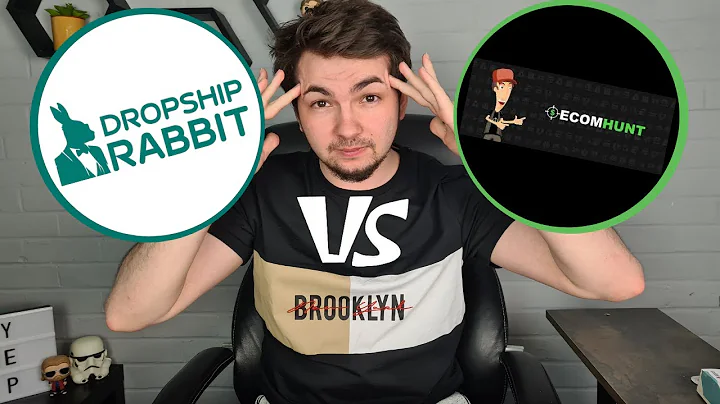The Truth About Amazon Drop Shipping: Is it Safe and Allowed?
Table of Contents
- Introduction
- What is Amazon Drop Shipping?
- Myths and Misconceptions
- Amazon's Official Stance on Drop Shipping
- Understanding Different Types of Drop Shipping
- The Difference Between Amazon Drop Shipping and Shopify Drop Shipping
- How to Find Good Products for Amazon Drop Shipping
- The Fulfillment Process for Amazon Drop Shipping
- Amazon's Requirements for Drop Shipping on Their Platform
- Tips for Success in Amazon Drop Shipping
- Comparing Amazon Drop Shipping with Other Business Models
- Conclusion
Article: Understanding Amazon Drop Shipping
Introduction
In today's video, I'm going to clear all your doubts regarding Amazon Drop Shipping. This model has been a controversial topic, with myths and misconceptions surrounding its legality on the Amazon platform. Many believe that engaging in Drop Shipping would lead to account suspension. However, the reality is quite different. In this article, I will provide you with 100% logic and proof, explaining why Amazon actually allows Drop Shipping and how you can avoid any issues that may lead to account suspension. If you're considering starting a business on Amazon, this information will be crucial in helping you make an informed decision.
What is Amazon Drop Shipping?
Let's start by understanding what Amazon Drop Shipping is. According to the official Amazon website, Drop Shipping is a fulfillment model that enables entrepreneurs to outsource the handling and shipping of products to a third party. Unlike the typical Shopify Drop Shipping method, where products are sourced from suppliers on AliExpress, Amazon's Drop Shipping operates differently. It requires you to purchase units of a product and send them to a third-party warehouse or fulfillment center. When an order is placed, the warehouse fulfills the order and ships the product directly to your customer. It's important to note that the packaging of the product should contain your brand name, address, and other relevant details.
Myths and Misconceptions
There are several myths around Amazon Drop Shipping that have led to confusion among sellers. One common misconception is that engaging in Drop Shipping will result in account suspension. However, this is not true. Amazon explicitly allows Drop Shipping on their platform. The reason behind the suspension of some accounts is usually due to sellers not following Amazon's guidelines. It's crucial to understand the requirements and policies set by Amazon to ensure compliance and avoid any account-related issues.
Amazon's Official Stance on Drop Shipping
To clarify any doubts, let's refer to Amazon's official website. Amazon clearly states that they allow Drop Shipping and have dedicated articles explaining how it works. This information can be found in the "What is Drop Shipping - How Does It Work in 2023" article. By providing this information, Amazon aims to make it clear that Drop Shipping is indeed allowed on their platform. However, it's essential to be aware of the specific guidelines and rules related to Amazon Drop Shipping to avoid any potential problems.
Understanding Different Types of Drop Shipping
It's important to differentiate between the various types of Drop Shipping. While Shopify Drop Shipping involves sourcing products from suppliers on AliExpress, Amazon Drop Shipping operates within the Amazon ecosystem. When engaging in Amazon Drop Shipping, you become a wholesaler or a drop shipper on Amazon, utilizing someone else's listing to sell your products. This model requires you to purchase inventory from a supplier and have a third-party warehouse fulfill and ship the orders on your behalf. The key distinction is that the packaging of the product should display your brand name and relevant details, unlike the Shopify model.
The Difference Between Amazon Drop Shipping and Shopify Drop Shipping
When comparing Amazon Drop Shipping with Shopify Drop Shipping, it's crucial to understand the fundamental differences. Amazon Drop Shipping requires you to purchase inventory upfront and send it to a third-party warehouse. When orders are placed, the warehouse fulfills and ships the products directly to the customers, with the packaging displaying your brand name. On the other hand, Shopify Drop Shipping involves running ads on platforms like Google, Facebook, or TikTok. When an order is received, you place the order with a supplier (typically on AliExpress or another drop shipping platform), and they ship the product directly to your customer. The packaging in this case would display the supplier's information, not yours.
How to Find Good Products for Amazon Drop Shipping
Finding profitable products is crucial for success in Amazon Drop Shipping. To start, you'll need to identify products that meet Amazon's guidelines for Drop Shipping. One effective method is to conduct thorough product research, considering factors such as demand, competition, and profit margins. In a previous video, I explained in detail how to find the right product for Amazon Drop Shipping. By following the tips and techniques outlined in that video, you can ensure you're selecting products that are suitable for Drop Shipping on Amazon.
The Fulfillment Process for Amazon Drop Shipping
Once you've identified suitable products, the fulfillment process is an integral part of Amazon Drop Shipping. After purchasing the necessary inventory, you'll need to send it to a third-party warehouse or fulfillment center. When an order is received, you forward the order details to the warehouse, and they handle the packaging, labeling, and shipping of the product to your customer. It's crucial to maintain clear communication with the fulfillment center to ensure smooth order processing. By understanding this process and streamlining your fulfillment operations, you can provide efficient service to your customers.
Amazon's Requirements for Drop Shipping on Their Platform
To maintain compliance with Amazon's policies, there are specific requirements to adhere to when engaging in Drop Shipping on their platform. One essential requirement is that you must identify yourself as the seller on the invoices, packing slips, external packaging, and other related items. This means that your store name should be prominently displayed on the packaging of the products you sell. Amazon does not allow Drop Shipping from external websites such as Walmart, eBay, or Etsy, where the packaging would display another brand. By keeping these requirements in mind, you can ensure a smooth drop shipping experience on Amazon.
Tips for Success in Amazon Drop Shipping
To maximize your success in Amazon Drop Shipping, there are several tips and best practices to keep in mind. It's essential to continuously monitor product performance and make strategic adjustments to optimize your listings. Additionally, focusing on customer service and promptly addressing any inquiries or concerns can help build trust and loyalty with your customers. By leveraging Amazon's advertising platform, you can effectively promote your products and drive more sales. Conducting thorough market research, staying updated on industry trends, and continuously learning and improving your strategies will contribute to your overall success in Amazon Drop Shipping.
Comparing Amazon Drop Shipping with Other Business Models
Before making a final decision on the best business model for your Amazon venture, it's essential to compare Amazon Drop Shipping with other available options. Some popular alternatives include Amazon Private Label, Wholesale, and Retail Arbitrage. Each has its unique advantages and considerations. By comparing the pros and cons of each model, you can determine which one aligns best with your goals, resources, and capabilities. Understanding the differences and weighing the benefits will assist you in making an informed decision.
Conclusion
In conclusion, Amazon Drop Shipping is a legitimate and viable business model on the Amazon platform. By following Amazon's guidelines and best practices, you can engage in Drop Shipping without the fear of account suspension. Understanding the differences between Amazon Drop Shipping and other business models, as well as conducting thorough product research, will contribute to your success. Remember to prioritize customer service and constantly adapt and improve your strategies to stay ahead in this competitive marketplace. With the right approach and dedication, Amazon Drop Shipping can be a lucrative and fulfilling venture.



















